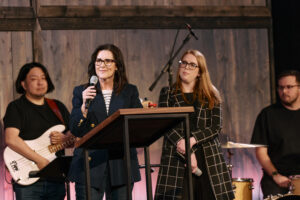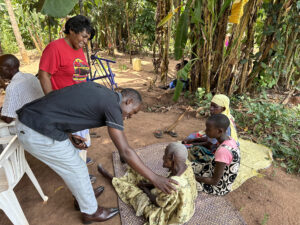
EDITOR’S NOTE: This is the first column in a three-part series on alcohol and the church.
CARROLLTON, Ga. (BP)–Only a few weeks ago, more than 1 million people gathered in New Orleans to celebrate Mardi Gras. And, while the crowds were obviously down compared to pre-Katrina days, party sponsors saw record post-Katrina numbers in the famous French Quarter.
Mardi Gras has been with us in some form since the early 18th century. Some historians trace its origins to medieval Europe when carnivals celebrated a final night of eating richer foods before fasting of the Lenten season begins. According to the Western Christian calendar, Lent starts on Ash Wednesday which serves as the official countdown of 46 days (minus Sundays) until Easter Sunday.
“Fat Tuesday” (English translation of the French, “Mardi Gras”) is more than feasting on fattening food, however. Since the official “Mardi Gras Act” was signed into Louisiana law in 1875, the New Orleans celebration has well earned the reputation as the biggest booze bash on American soil. Aside from the “parade throws” of doubloons, brightly colored jewelry (fake, of course), souvenir cups, and other crowd-pleasing dainties the elaborate float crews throw into the crowds, it’s non-stop drinking, carousing, and plain-old vulgarity on steroids.
Not to be confused with the frolicking of Mardi Gras is St. Patrick’s Day celebrations. Like Mardi Gras, St. Patrick’s Day began as a religious celebration. And, like Mardi Gras, St. Patrick’s Day has been thoroughly severed from its primarily religious rootedness, focusing more on indulgence than inspiration. Admittedly, there remain some wholesome aspects to St. Patrick’s Day. Unfortunately, however, most emphasis goes toward loose and wild drinking at local pubs than to any positive contributions to our collective socio-conscience. Even in Ireland, where religious roots still remain connected to St. Patrick’s Day celebrations, pubs which were once closed on this sacrosanct day, are now open (and opened only recently) due to the public demand for indulgence.
Therefore, one must wonder if any redeeming qualities remain for many of America’s cherished socio-cultural celebrations. Even more, given our cultural inclination toward indulgence of dangerous intoxicants like alcohol, one must query if celebrations like Mardi Gras and, in a lesser respect, St. Patrick’s Day, reflect what we desire our next generation to emulate. Allow me to show you what I mean.
In 2008, according to the Centers for Disease Control and Prevention (CDC), “11,773 people were killed in alcohol-impaired driving crashes,” accounting for about one-third “of all traffic-related deaths in the United States.” Additionally, more than “1.4 million drivers were arrested for driving under the influence of alcohol or narcotics.”
The stats are just as tragic for young people. In 2003, 31 percent of drivers age 15 to 20 who died in traffic accidents had been drinking alcohol, and in 2008, more than 10 million persons aged 12 to 20 reported drinking alcohol in the past month. That translates roughly to 26.4 percent of this age group, an age group we cannot fail to notice was drinking alcoholic beverages illegally. That’s more than 1 in 4 obtaining dangerous intoxicants illegitimately.
Even more disheartening is that 6.6 million of underage drinkers in 2008 were also “binge drinkers” (admittedly lower than in 2007 but nevertheless alarming). According to the CDC, “binge drinking” is defined as drinking patterns that brings a person’s blood alcohol concentration to 0.08 grams percent or above. “This typically happens when men consume 5 or more drinks, and when women consume 4 or more drinks, in about 2 hours,” the CDC says. I would add that the majority of “binge drinkers” are not typically considered alcoholics even though they severely abuse intoxicating beverages.
College students may be our biggest challenge. According to the latest CDC numbers, those between the ages of 18 and 22 who were enrolled in full-time college studies were more likely than their peers not enrolled full time to use alcohol. In fact, they were also more likely to severely abuse alcohol. A whopping 61 percent of full-time college students in 2008 were current drinkers. More significantly, over 40 percent practiced “binge drinking” with another 16 percent classified as virtually dependent (heavy drinkers). And while the percentage of current alcohol users decreased somewhat from 2007 to 2008 (a statistic we may applaud), the overall pattern has remained statistically consistent since 2002.
Perhaps we need to be reminded at this juncture that the studies on the usage of alcoholic beverages rightly do not focus on a false distinction between different kinds of “drinks.” One myth which surely needs a proper burial once and for all is the false presumption that intoxication potential is greater in consuming a serving of bourbon than a standard bottle of beer. Or even more popular is the belief that table wine carries the least intoxicating “punch” of any alcoholic beverage. The fact is, however, a typical can of beer (12 ounces), a shot of distilled spirits (1.5 ounces), and a serving of wine (5 ounces) have precisely the same amount of ethanol alcohol. Hence, one can rightly say, alcohol is alcohol is alcohol. One may get just as buzzed on a glass of wine as one does a mixed bourbon. Far too many succumb to the deception that drinking wine is not as “bad” as drinking whiskey. Remember: alcohol is alcohol is alcohol regardless of experiencing the buzz via bourbon, fine wines, or fancy fruit “wine-coolers.”
Where are all the underage drinkers getting their alcohol? In 2008, more than 56 percent of drinkers aged 12 to 20 reported their most recent use of alcohol (within 30 days) occurred in someone else’s home. However, almost 30 percent reported they drank in their own home.
About a third of underage drinkers pay for alcohol use, but only a fraction of those actually purchase the alcohol themselves (8.3 percent). The other two-thirds majority got the alcohol from persons over age 21 (37 percent) or persons aged 12-20 (21 percent). Most troubling is that more than 1 in 5 underage drinkers get their alcohol from a parent, a guardian or other family member over age 21. Consequently, parents themselves are in some way directly responsible for thousands of teens killed on our highways every year, a horrifying but necessary reality to face.
With such a bleak picture of the drinking patterns of our next generation in mind, we ask once again whether “Fat Tuesday” and all the indulgence surrounding the biggest booze bash in America should remain a contemporary celebration birthed from medieval Christianity? With our most sacred responsibilities as parents at risk, how can we say yes to an age of indulgence?
–30–
Peter Lumpkins is a Southern Baptist minister who lives in West Georgia. He is the author of “Alcohol Today: Abstinence in an Age of Indulgence” (Hannibal Books).

















